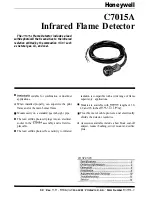
DP-PSUEN EN54-4 Fire Alarm Power Supply Series
– INSTALLATION & OPERATION MANUAL
DP-PSUEN Series Installation & Operation Manual Rev 11.1 220323.docx
E&OE
- 11 -
sensor as supplied is to be fitted between the batteries. The size of the batteries is dependent on the size of the
box, the load current and the amount of standby time required. The medium box will house two 7Ah batteries and
the large box two 17Ah batteries. The battery cables are to be segregated from the incoming AC power supply
wiring.
5.9.1
Battery Temperature Remote Sensor Fitting
A remote battery sensor is supplied for accurate temperature compensation to comply with EN54-4 requirements.
The sensor is plugged into the TEMP 3-way socket and the EXT jumper must be removed to enable the sensor.
The sensor is supplied with a 200mm lead so the sensor head can be fixed between the batteries with a self-
adhesive fixing plate and ty-wrap as provided. The power supply is not to be used with the EXT Jumper link
removed without a remote temperature sensor fitted.
5.9.2
Battery Protection
The batteries are reverse connection protected and the battery charging output is protected from short circuits.
The battery output is overload protected by a resettable fuse, in addition to the electronic output fuses. If this fuse is
tripped then the batteries should be disconnected for 5 minutes to allow the fuse to reset.
When in standby mode the battery is switched off when the battery terminal voltage reaches 20V to prevent battery
deep discharge damage. This fault is normally reset by restoring the AC power supply.
5.9.3
General Maintenance
NB:
WARNING: Isolate the AC power supply before removing the power supply lid. Do not touch
components or heat sinks as there is risk of electric shock or burn hazard.
The power supply should be regularly inspected by qualified personnel and the following checked:
1. No faults are displayed.
2. Battery terminals checked for corrosion and the terminals are securely tightened.
3. All the connections into the power supply terminal blocks are secure.
4. The battery voltages are checked and the voltages are balanced within a volt to each other. The battery
manufacturer’s specifications should be consulted when making battery voltage measurements.
5. Battery replacement is recommended after a 5-year service life.
6. Check there are no signs of water or moisture ingress and there is no mechanical damage to the enclosure.
7. Check for signs of overheating on the power supply board and battery cases.
8. Check the voltage outputs, they should be nominally between 26.5V and 28.5V depending on temperature.
9. There are no replaceable input, battery or output fuses. In the event of a fault the power supply board will have
to be replaced.

























